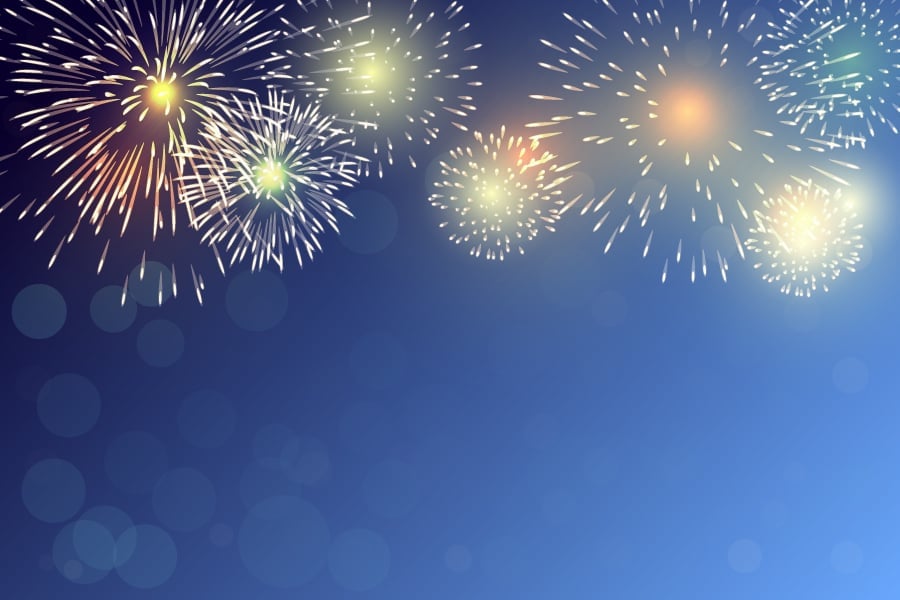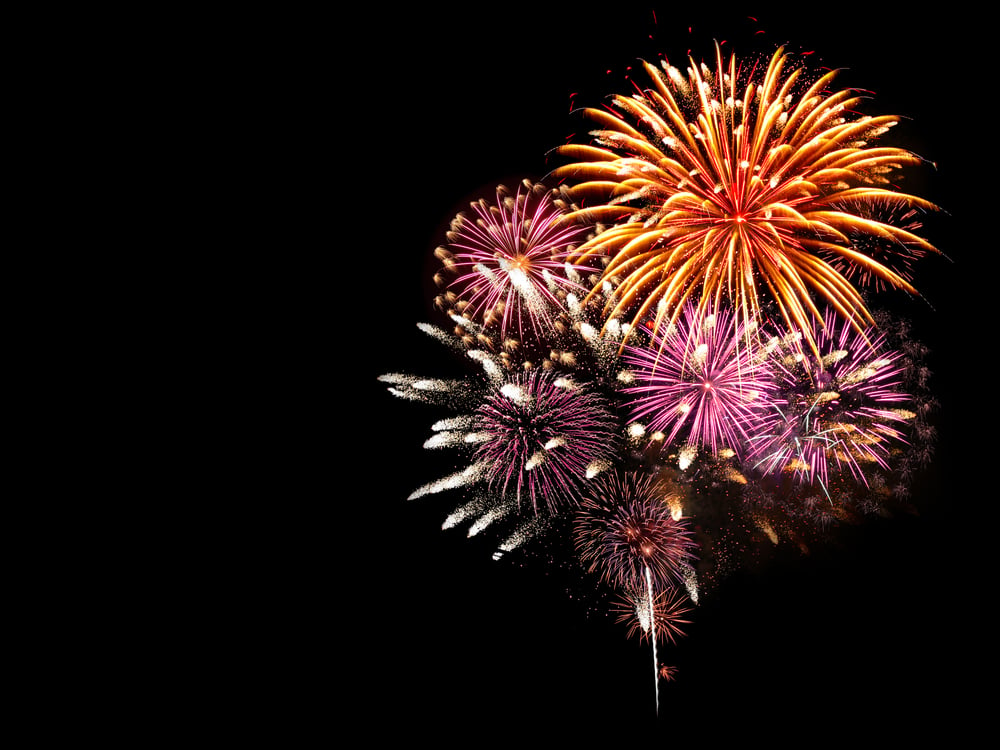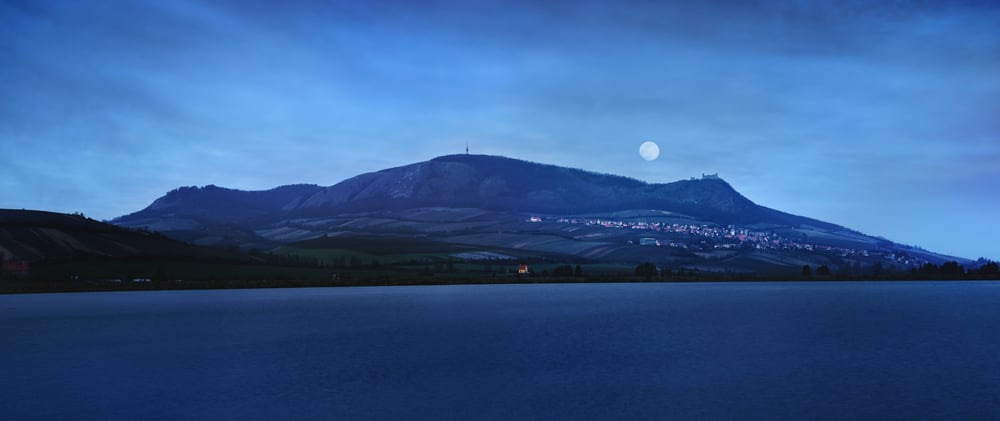When making a firework what do pyrotechnicians use to add color to a firework?
Blueish firework are more difficult to create compared to other colors due to the weird chemistry that comes into play at higher temperatures. The instability of compounds that impart that blue color in fireworks is the culprit.
We have relished fireworks for millennia, and information technology goes without saying that they are vibrant and cute. Whether they come at a long-awaited annual anniversary or simply a casual celebration, fireworks are a go-to feature to make those precious events even more memorable by lighting upwardly the heavens. Fireworks alluvion the sky with vivid bursts of white, golden, red, emerald, yellow and pinkish.

Beautiful fireworks (Photograph Credit : milezaway/Shutterstock)
However, while gazing upwardly at awe-inspiring bursts of fireworks in the heaven, have y'all ever noticed that one color is generally missing?
Yes, bluish is rarely present in a fireworks display, but why is that the case? What makes it then hard to produce blueish fireworks? Before we go into that question, permit's have a brief await at how we started using fireworks in the first place.
Recommended Video for you:
History of fireworks: Blue was always elusive!
At that place is quite an interesting history behind why humans invented fireworks. The Chinese were the first to brand fireworks as early every bit 200 BC. In fact, the invention and apply of fireworks occurred quite serendipitously. Information technology took more than than a millennium for fireworks to be used as a means of celebration. The original fireworks in China were designed to scare abroad evil spirits with loud dissonance and vivid lights. Those fireworks were very loud and not as tightly controlled as the fireworks we run into today.

Italians in the seventeenth century figured out that by adding certain chemicals to the fireworks, bright colors like red, xanthous, or white could be created.
Since then, pyrotechnicians all over the world have been trying to effectively create "blue" fireworks, but they oasis't really succeeded, so why are blue firework so elusive? John Conkling, manager of the American Pyrotechnics Association, reckons that blueish is very difficult to achieve, as compared to colors like ruddy, orange, white, or yellow, due to the weird chemistry that comes into play at higher temperatures. The instability of compounds that impart that blue colour to fireworks is the culprit. To fully understand that, nosotros need to understand how fireworks function.
Science of fireworks
Nigh fireworks we see incorporate five components: fuel, coloring agent, mucilage, fuse, and pellet.
The fuel in fireworks is often gunpowder. The coloring agent is the chemic compound that decides what color firework will appear after the explosion. These chemicals are often metal salts, and the employ of different metal salts will create different colors or a mixture of them will create a mixture of colors. Sodium salts volition create a xanthous color, strontium salts will make red, aluminum salts generate grayness, barium salts effect in light-green, and copper salts (theoretically) produce blue!
Gunpowder with the coloring chemicals is held together by applying special pyro mucilage. A fuse is the pyrotechnic-initiating string, the part with which you lot ignite the firecracker. All of these elements are finally encased in a pellet, which we employ as firecrackers!
When you shoot the lit pellet into the air, the fuse starts burning up, and eventually sets off the gunpowder, which explodes. This explosion heats the color-producing metallic salts, causing them to glow, and Nail! You lot get fantastic sparkling showers of colorful fireworks!

Vibrant fireworks (Photograph Credit : Dana.Due south/Shutterstock)
Information technology turns out that the hotter you lot tin can get color-producing chemicals in the flame, the greater the emission in the form of light. In other words, it will result in brighter colors.
But there'southward a trouble…
Problem with copper chloride (salt which imparts 'bluish' colour)
If the temperature gets too hot, it will interruption downwards the color-producing chemicals and wash out their colors. Additionally, some coloring chemicals are more resilient than others. Strontium chloride, for example, which imparts the red color in fireworks, can easily withstand temperatures up to 1500o Fahrenheit. However, copper chloride, which is used to create blue fireworks, is far more fragile. As presently as it gets hot enough to impart a blue color—around chiliado Fahrenheit—information technology starts to suspension downwards and fade.
To showtime this consequence, pyrotechnicians need to add more chemicals to copper chloride, such that the mixture tin get hot plenty to retain its blue color without fading. Equally information technology turns out, despite centuries of piece of work in this direction, nosotros aren't quite in that location yet!
Although we have found some alternatives, they are either too expensive or too dangerous to be used in fireworks. For example, arsenic was used in some fireworks long ago to generate a blue color, but manufacturers shortly realized that arsenic was besides toxic to be used in firecrackers and stopped implementing that clever solution.
Blue sky in dissimilarity to the groundwork
Another trouble associated with making blueish fireworks is that the color of the sky in the early evening is also blue. This makes many shades of blue go unnoticed in the sky, in contrast to the groundwork. To burnish them up would require higher temperatures, and college temperatures mean the brilliant bluish color will exist done out, as explained above.

Early evening sky (Photo Credit : JDzacovsky/Shutterstock)
A last word
If you call back about it, the color blueish in itself is elusive. It is 1 of those colors that is very hard to find in nature. All the same, blue happens to be i of the most liked colors.
Even if we haven't managed to create sparkling brilliant bluish fireworks yet, John Conkling, the pyrotechnics adept, is still hopeful. He says that there are a few ongoing studies to find a suitable and safe chemical to impart bluish color to fireworks, then, in that location could be a breakthrough in the futurity! Possibly one twenty-four hours we will have American flag-colored fireworks of sparkling blue, ruby-red and white for the fourth of July!
Suggested Reading
-
Elements of Chemistry (Dover Books on Chemistry) -
Silent Witnesses: The Often Gruesome But Always Fascinating History of Forensic Scientific discipline -
The Alchemy of Air: A Jewish Genius, a Doomed Tycoon, and the Scientific Discovery That Fed the World only Fueled the Rise of Hitler
Help us make this article meliorate
taylorfingrifuread.blogspot.com
Source: https://www.scienceabc.com/eyeopeners/why-are-blue-fireworks-rare.html



ارسال یک نظر for "When making a firework what do pyrotechnicians use to add color to a firework?"